#pond sliders
Explore tagged Tumblr posts
Text

Pond Slider Sweetwater Wetlands Park Tucson, Arizona, USA March, 2019
Likely a red-eared slider, but no red patch is visible.
(more turtles here)
15 notes
·
View notes
Text

Happy Together
#photo of the day#photography#red eared slider#turtles#i like turtles#reptiles#pond sliders#nature photography#wildlife photography#wild nj#scenic#nikon photography#nikon coolpix p1000#bayonne park#summer 2024
10 notes
·
View notes
Text

Untitled.
#photographers on tumblr#turtle#red-eared pond slider#Trachemys scripta elegans#non-native#Agua Caliente Park#Tucson#Pima County#Arizona
115 notes
·
View notes
Text
Wet Beast Wednesday: red-eared slider
It's turtle time, everybody! Today's topic, the red-eared slider turtle, is one of three subspecies of the pond slider, Trachemys scripta. The other two subspecies, the yellow-bellied slider and Cumberland slider are similar and I will mention them, but this post will largely be about the red-eared slider. Red-ears are the most popular pet turtle and as a direct result of that, is the most invasive turtle in the world.
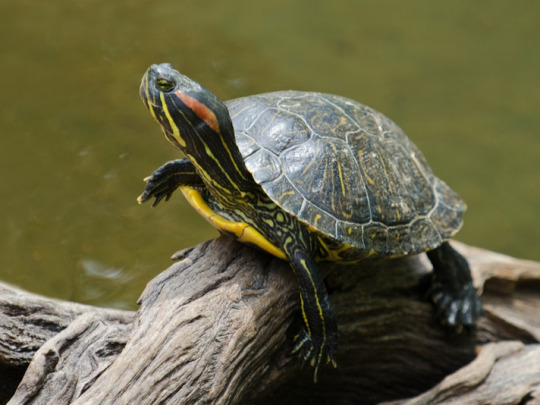
(Image: a red-eared slider basking on a log. It is a small turtle with a dark green upper shell striped with yellow and brown. Its body is a very dark green, almost black, with yellow stripes. A red stripe runs behind the eyes. End ID)
Trachemys scripta elegans is knows as the red-eared slider because of the red markings on the sides of its head and its ability to quickly slid into the water when threatened. They are freshwater turtles who reach an average of 15 - 20 cm (6-8 in) in carapace (upper shell) length, but can grow over 40 cm (16 in) in good conditions. The shell is composed of bony, keratinous scutes and varies in appearance as the turtle ages. The carapace starts out as a strong green color with variable markings and darkens to a brown color as the turtle ages. The plastron (lower shell) starts out yellow with darker markings and can darken to a red color with age. The turtle's skin is green with yellow stripes and also darkens with age. The shells and skin are always covered with stripes and irregular markings that help camouflage the animal by breaking up its silhouette. They have no external ear canals. Instead, the ear is covered with a disc of cartilage called the tympanum. During winter, they enter a state called brumantion, which is similar to hibernation but requires the turtle to occasionally wake up to eat and breathe.
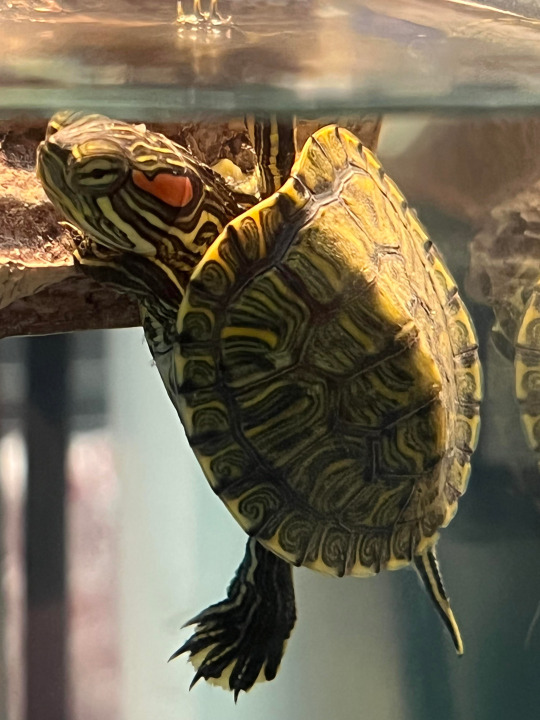
(Image: a juvenile red-eared slider in a tank. Its shell and skin are a lighter green and still heavily striped. The toes on one foot are spread, showing off the webbing between them. End ID)
It can be difficult to tell male and female red-eared sliders apart, especially when they are juveniles, but there are a few tells. Females usually get larger than males while the males have longer claws used to grab onto the female's shell while mating. Males also have a slightly concave plastron that helps them balance on the female's shell during mating. The biggest tell is the cloaca, which is located on the tail. In males, the cloaca opening is close to the tip of the tail, while in females it is close to the base.
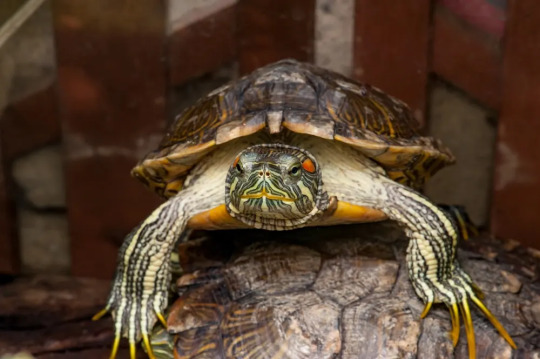
(Image: a red-eared slider seen from the front. It is identifiable as a male by its long claws. End ID)
Red-eared sliders are native to lakes, ponds, and slow-moving streams and rivers of the American midwest (which, for those of you who don't know, is on the east side of the country) and northern Mexico. They are omnivorous, feeding on aquatic and shore plants as well as aquatic invertebrates and small fish. They are not social, but tolerate each other's presence as long as there is enough food for everyone. In lean times, they will compete over food. Red-eared sliders are almost entirely aquatic, but they need to leave the water to warm their bodied by basking in the sun. Pond sliders can often be seen basking on rocks or logs sticking out of the water. They will bask in groups and even climb on top of each other. When they see danger, they will retreat into the water.
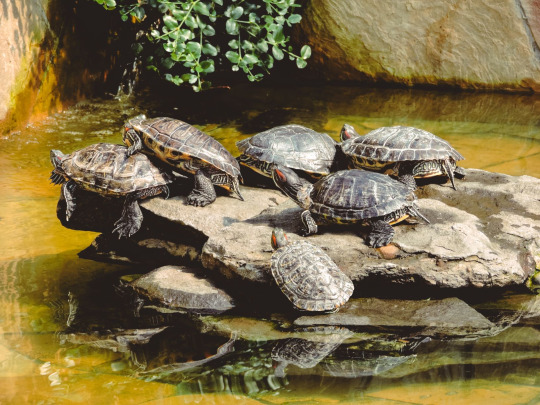
(image: a group of 6 red-eared sliders basking on a rock. One of them has partially climbed on top of another. End ID)
Mating season begin in spring and lasts until summer. Males will perform a courtship dance for females. He swims around the female while touching her head with the backs of his claws. This may help direct pheromones toward her. If the female approves, she will sink to the bottom and become receptive to mating. Otherwise, she will chase the male away. Courtship can take almost an hour, but the mating itself is short, lasting no more than 10 minutes. The time between fertilization and egg-laying can vary and females can hold onto sperm to fertilize herself later. Before laying eggs, females often have a change of diet and will spend extra time basking. The female will also spend more time on land, looking for a good spot to build a nest. The nest is a shallow pit dug in sand or loose soil. The female will lay between 2 and 30 eggs in the nest and bury them before leaving. A female can lay up to 5 clutches in a year. Incubation takes between 60 and 112 days. The temperature of the nest determines the sex of the hatchlings, with warmer soil producing females. The hatchlings use an egg tooth to break out of the egg, which will fall off a few hours after birth. Hatchlings are born with an external yolk sac attached to the bottom of the plastron that will provide nutrition for days after birth. The yolk sac being damaged or jostled enough to introduce air is fatal. The juvenile turtle needs to fully absorb the yolk sac and allow its plastron to fully fuse before entering the water, which takes about 21 days. Juveniles born late enough in the year may brumate in the nest and not emerge until next spring. Red-eared sliders reach sexual maturity at about 5 years of age and a turtle that survives its two years can live up to 30 or 40 years. Red-eared sliders can hybridize with the other pond slider subspecies.
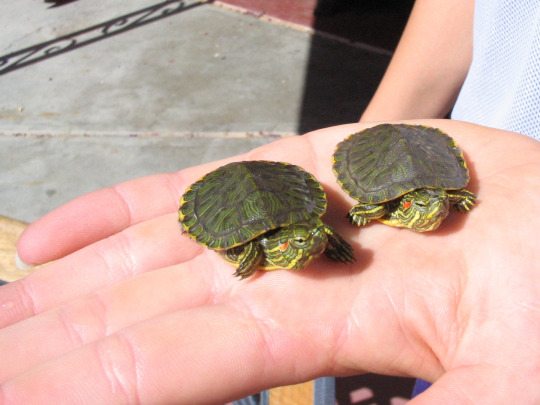
(Image: a pair of juvenile red-eared sliders being held in someone's hand. They are small enough that both together don't take up the full palm. End ID)
Red-eared sliders are classified as least concern by the IUCN, meaning they are not at risk of extinction. They have become popular pets due to being cheap with low maintenance costs and not getting too big. They are the world's most commonly traded reptile thanks to the pet trade, though they are also eaten by some people. Release or escape of pet red-eared sliders had led to them becoming an invasive species in many parts of the world as their fast maturation allows them to outcompete local species. They have also been responsible for spreading diseases and parasites to native turtle populations. Red-eared sliders are also asymptomatic carriers of salmonella and need to be handled with caution. I leave you with a fun fact: the Teenage Mutant Ninja Turtles are, in at least one continuity, red-eared sliders
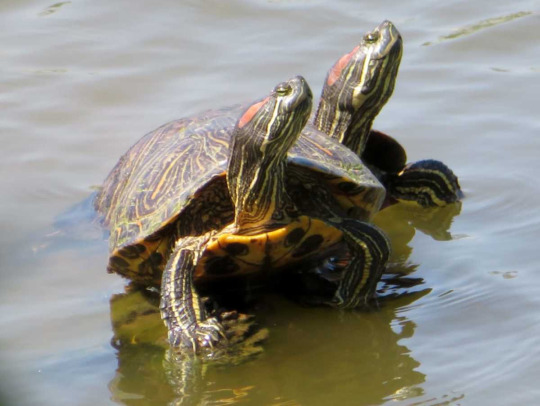
(Image: a pair of red-eared sliders standing in shallow water. their necks are extended and they are looking upwards. End ID)
#wet beast wednesday#red eared slider#pond slider#turtle#turtles#reptile#herpetology#freshwater ecology#ecology#biology#zoology#animal facts#informative#educational#image described
60 notes
·
View notes
Text

Duck Photobombing Red-Eared Slider
#artists on tumblr#original photographers#original photography#hiking#pacific northwest#nature#washington#orofeaiel#pnw#nikon#duck#mallard#photobomb#animals#turtle#red-eared slider#pond#birb#wildlife
113 notes
·
View notes
Text
would u like 2 see two turtle friends ?? 🐢


#sam.img#from our pond right outside my bedroom window !#they’re red-eared sliders ! we also have albinos
35 notes
·
View notes
Text



My girlfriend went on a trip recently and sent over some cool fellas she found and I wanted to share!
A white nosed coati, a central American spider monkey, and a few pond sliders!
#animals#nature#critters#mammals#wild life#wildlife#coati#white nosed coati#mokey#spider monkey#central American spider monkey#pond slider#turtles
13 notes
·
View notes
Text


the dreamer - 11/6/24
6 notes
·
View notes
Text
While volunteering at a festival at the state park over the weekend, I came across the highlight of my week: someone found a baby turtle in their kayak! She released the baby back into the lake, where it swam away.
(Unfortunately, this is a red eared slider, an invasive species. Still, it's damn cute.)

18 notes
·
View notes
Text


i found a turtle!!! she was in a hardee's parking lot where she def does not belong!! there seems to be a lil crack on her tummy in the second pic?? i admittedly know next to nothing about turtles. but i love her and i moved her somewhere safer!!
#hopefully she finds somewhere safe to live#ik my dad wouldnt wanna drive to the nearest pond rn bc hes a bit sick#but yeah!! turtle!!#turtle#yellow bellied slider#wildlife#idk what else to tag im just!!! happy!! i love animal
10 notes
·
View notes
Text
was driving home and found a large turtle near an intersection, a long ass way away from the canal that she had to have come from. she was way too big to be a chicken turtle. either a cooter or a slider i think
anyway she must’ve been exhausted bc she was at least a mile from the canal and there’s no other body of water that i know of nearby. and she looked like she was just minutes from heading into traffic from the grassy swale
so i picked her up and put her in my lap and figured i’d drive her to the pond near my house bc even though it’s far from her home it’s a hell of a lot better than getting hit
she peeped her head out as we were driving, inspecting the AC vents, but otherwise she just sat quietly on my lap, looking around
and then when we got there she scrambled into the pond and disappeared with gusto so hopefully she was happy to not have to keep traveling near all that loud confusing traffic
#we have both cooters and sliders in that pond so i think she’ll be happy#they all sun themselves in a row on the bank every day
38 notes
·
View notes
Text

Pond Slider Trachemys scripta
8/3/2022 Orange County, California
#turtle#turtles#pond turtle#pond turtles#pond slider#slider#sliders#reptiles#reptile#reptiblr#my photos
6 notes
·
View notes
Text

#photo of the day#photography#pond slider#turtle#i like turtles#reptile#reptiles are cool#nature photography#wildlife photography#wild nj#scenic#scenic photography#nikon photography#nikon coolpix p1000#Bayonne Park#nj isnt boring#fall 2024
7 notes
·
View notes
Text

It’s not always about the birds when out bird watching. Beus pond has lots of turtles as well. They spend some time out of the water sunning themselves. A perfect chance to get a few shots.
9 notes
·
View notes
Text

Trachemys scripta
Done for SCAD DSGN 100
3 notes
·
View notes
Note
Assumption for true or false thing!
You like ALL turtles, not just teenage mutant ninja ones.
TRUE
They’re so silly,,,
4 notes
·
View notes